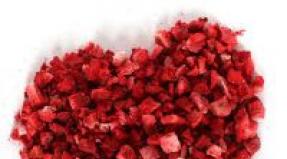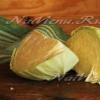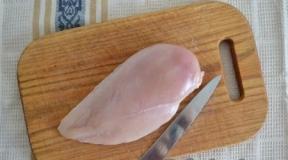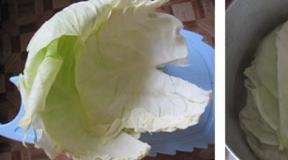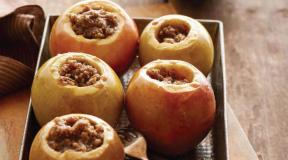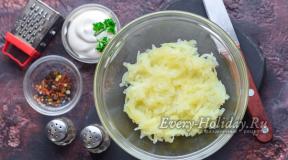How to make cottage cheese at home? Cottage cheese at home - recipe. Make cottage cheese at home - the best recipes
Making cottage cheese from milk at home is a completely simple process. And the resulting product will be both healthier and tastier than cottage cheese purchased on the market or in a supermarket.
Ingredients:
3 liters of milk poured into a glass jar;
- pan;
- colander;
- gauze.
How to make cottage cheese from milk at home:
To make good cottage cheese, it is best to use natural homemade or farm milk. A pasteurized product from the store will most likely not work. The quality and purity of milk should not cause you any doubts, because milk cannot be boiled - good cottage cheese does not tolerate high temperatures.
A jar of fresh milk does not need to be refrigerated, it should be in a warm place. After 2-3 days, the milk should turn into curdled milk. When the curdled milk is ready, you can see the vertical "moves". They are formed by bubbles of carbon dioxide rising up. Ready yogurt resembles jelly, easily separated from the walls of the jar. It is extremely important to make sure that the milk does not peroxide, otherwise the cottage cheese will turn out to be very sour.
If the milk was of high quality, then a sufficiently large amount of cream is formed on the surface of the resulting yogurt, which must be skimmed off. The more of them left, the fatter the cottage cheese will turn out. In this way, you can achieve the fat content of the final product you need.
A jar of curdled milk should be placed in a saucepan, which is on fire (very weak) and on the bottom of which a thick rag, folded in several layers, is previously placed. Pour water into the pan so that it reaches the middle of the jar.
To warm up the curdled milk better, you should take a knife with a long blade and cut it crosswise. The jar must be covered with a small piece of gauze. The curdled milk should be in the pan until the water starts to boil, but in no case should it boil. This process will take approximately one hour. After that, the fire must be turned off and the jar of yogurt, from which the whey has already separated, should be left in hot water for another 10 minutes.
In the meantime, you need to prepare the dishes into which the whey will be poured, and a colander covered with a sufficiently large piece of gauze folded 3-4 times, or with a thick cotton cloth. The curd will remain in it. It is necessary to shake out the contents of the jar carefully in order to preserve the integrity of the product as much as possible, because the larger the pieces of curdled yogurt, the tastier the cottage cheese will turn out.
Next, the edges of the gauze must be lifted up, tied and hung over a container into which the whey will drain. You can tie cheesecloth with cottage cheese, for example, to the handle of a kitchen drawer, and put a container for whey on a stool under it.
It is impossible to squeeze the cottage cheese with your hands, because the structure of the product may be damaged, and it will turn out dry and grainy. The serum should drain itself. The cottage cheese will be ready when it absolutely stops dripping from the gauze.
From 3 liters of milk, you can get from 500 to 800 g of cottage cheese. It depends on the fat content of milk, and on the moisture content of the final product. Cottage cheese prepared according to this recipe turns out to be quite dense, but not dry, moderately fatty and with a very pleasant, milky, not sour smell.
From this homemade cottage cheese you can make delicious homemade cheesecakes according to our recipe!
There are products whose taste has been familiar to us since childhood. These include cottage cheese - the undisputed king of the dairy kingdom. So, it would seem, there is nothing easier than making cottage cheese at home. This can be afforded by anyone who at least somehow cares about their health and their loved ones. Moreover, a home-made product is much healthier and tastier than a store-bought one. However, despite the seeming simplicity of the process, few people do it regularly.
How to cook homemade cottage cheese
At home, the preparation of this fermented milk product takes several days. This simplest classic recipe requires only good full-fat homemade cow's milk - and nothing else is needed! Milk bought in a supermarket is not suitable, as it is pasteurized. Three liters of good milk produces less than a kilogram of cottage cheese. Note that whey is often not completely drained from a store product, which leads to an increase in mass and a reduction in shelf life. We will be able to produce quite dry and crumbly cottage cheese!
Cooking technology
We just leave the jar of milk covered with gauze in the kitchen for souring. The process will start by itself, no need to add anything to the milk! If the apartment is not warm enough, you need to put the jar near the stove or battery. When a thick white lump forms, the sour raw material is ready for further transformations (the longer it sits, the sourer if you like it). First, leave the raw material to sour for two days. Over time, you will already know when to stop the sourdough process, adjusting the time so that you get the most delicious cottage cheese.
Then slowly pour the raw materials into the pan (trying not to shake) and put on the smallest fire. We heat until the whey separates. You can't boil! Long keep on fire - too! If brought to a boil, then our cottage cheese will look more like rubber than a delicate and tasty product. Moreover, when boiling, all useful microflora dies.
After we remove the future cottage cheese from the stove, let it cool for a while. We are preparing a colander for further action. We take gauze, fold it several times and put it in the center of a colander. We pass the already cooled mass through this filter. We substitute a bowl under a colander to use the expressed whey. When the liquid has completely drained, the edges of the gauze must be tied, and the structure should be hung over the bowl until the liquid stops dripping. Manual pressing is prohibited! Everything should happen naturally. We extract the mass. The curd is ready! This is the most common answer to the question of how to make cottage cheese at home.

Kefir or yogurt
You can try to make cottage cheese from kefir, yogurt at home. The cooking process is the same as in the first recipe, but instead of milk, we use either one or the other. The fat content of the resulting cottage cheese will depend on the fat content of kefir, and yogurt, of course, must be natural, “live”, without dyes and fruit additives. It’s better to put slices of fresh fruit into our cottage cheese later.
For baby
The child begins to give cottage cheese from five to six months - in a carefully ground form, at the very beginning of feeding. The dose gradually rises to 30 grams, so there is no need to cook the curd on a global scale. By the year, the daily norm is only 50 grams. Do not give such young children the cottage cheese that is sold in the markets, as it has a short shelf life, and the fat content is not entirely suitable. It is better to cook cottage cheese at home.

Recipe 1. In a water bath
You need to take kefir (from the dairy kitchen), pour it into a saucepan and put it in a water bath (up to 70 degrees). Keep at this temperature until a dense clot forms. Next, drain the whey and wipe through a sieve (remember about small amounts - from 500 grams of kefir you should get about 50-70 grams of cottage cheese, just a daily portion for a baby). You don’t need to prepare for the future, it’s better to make fresh tomorrow!
Recipe 2. Delicate cottage cheese
Add a little yogurt to the milk and bring the mixture to a boil, but do not boil! Throw on a sieve. The curd is ready. It turns out very gentle in this way. To taste, you can add a spoonful of fruit puree there.
Recipe 3. Freeze
You need to freeze a pack of kefir in soft packaging in the freezer. Then we cut the polyethylene, put it in a sieve, defrost, strain. The curd is ready!

Recipe 4. With pharmacy additive
We boil milk, pour 10% calcium chloride into the hot one (we buy it at the pharmacy) at the rate of: a tablespoon per glass of milk. It immediately starts to curl up. Set aside to allow excess liquid to glass. We rub through a sieve. Can be diluted with boiled milk.
Dietary
If you are going to make low-fat cottage cheese at home, you must either immediately take low-fat milk as a basis, or remove cream from milk starting to sour during the cooking process. Thus, a low-fat dietary product is obtained for those who monitor weight or follow a diet.

From goat milk
This is a wonderful all-round product for all ages. In regions where goat milk and sour-milk products from it are regularly consumed, people get sick less, they are not bothered by excess weight and insomnia. This is due to the unique properties of this milk, which can be consumed by both allergy sufferers and people suffering from diseases of the stomach and heart. Goat cottage cheese at home is also quite simple to prepare. There are several popular recipes for those who decide to learn how to make cottage cheese at home.
Serum
You need to take six liters of goat's milk (the output will be one kilogram of mass). Put for fermentation in heat. To speed up the process, add about a glass of sour whey. The souring process lasts a day in summer, and up to 3 days in winter. When the pieces of the mass are separated, the raw material is ready. For the convenience of further actions, pour into two three-liter jars (you can do this right away). We then heat the curdled milk in a water bath (up to 70 degrees) for about half an hour. As a result, the whey falls down, and the curd floats at the top. We take out the jars from the pans, let them cool. We filter the cooled raw materials through gauze. You can drain the whey with a rubber tube, and only then filter it. We tie the gauze in a knot and hang it up overnight. In the morning goat curd is ready.

In a slow cooker
How to make cottage cheese at home if you already have a slow cooker that has been so fashionable lately? Buy three liters of goat's milk, add a glass of kefir, mix and put in a warm place for fermentation (usually for a day). Curdled milk should be thick, with large feathers. Pour the liquid into the multicooker bowl without stirring. We put on the “Heating” mode for three hours. Strain through a fine sieve. The curd is ready!
On a bread crust
A simple, affordable way even for a novice in cooking. It is necessary to add a small crust of rye bread to improve the souring process of milk. At the end of the process, we extract it from yogurt. Next, follow the basic recipe.
As you can see, for those who decide to learn how to make cottage cheese at home, there are many recipes that allow you to produce this delicious and healthy product.
Probably, everyone has heard about the health benefits of dairy products. Such food is an excellent source of calcium and easily digestible protein, contains many vitamins and other elements necessary for the normal functioning of organs and systems. It is not for nothing that many pediatricians advise introducing milk into the diet of crumbs as early as six to eight months. Unfortunately, it is difficult to buy really high-quality dairy products in modern stores, but many of them can be prepared on your own. Let's clarify how to make cottage cheese at home quickly.
How to make cottage cheese easy and fast?
To prepare such a dairy product, you need a minimum of ingredients. You do not need to use pepsin and purchase starter cultures, you just need to stock up on one liter of fresh milk, half a teaspoon of salt and three tablespoons of lemon.
In a fairly large saucepan, combine milk and salt. Bring this mixture almost to a boil, but do not let it boil. Turn off the stove and pour the lemon juice into the milk, stirring. As a result, the milk will curdle in flakes. Leave it for five to seven minutes, during which time stir several times. If you want the finished cottage cheese to have a particularly pleasant creamy taste, add a tablespoon of heavy cream to the mass.
Cover the bowl with gauze folded in two or three layers. Pour the curd mixture over it. Carefully tie the edges of the gauze with a bag and lift it up. Place in a colander or even hang to drain excess liquid (whey). The more time the cottage cheese will give liquid, the more dry and dense it will turn out as a result.
In general, it will take you forty-five to sixty minutes to prepare juicy, tasty, tender and very healthy cottage cheese. Write down this method for yourself as the easiest and fastest recipe for tender homemade cottage cheese.
How to make cottage cheese quickly so that it is very, very tasty?
To prepare quick homemade cottage cheese, you need to prepare two liters of kefir (2.5% fat) and two liters of milk (also 2.5% fat).
Rinse a suitably sized pot with cold water. Pour milk and kefir into it. Stir the resulting mixture. Cover the pan with a lid and send it to the stove on the largest burner. Soak on a fire of minimum power for half an hour.
Wait until the mass in the pan begins to separate a clear whey. Stir the future cottage cheese with a spoon, carefully turning it from bottom to top. Cover again and leave for another twenty minutes. But in no case do not let the whey boil.
Leave the future cottage cheese under the lid until it cools completely, then carefully fish it out with a slotted spoon and put it in a colander. Leave in the refrigerator for three hours.
For taste, add condensed milk to the cottage cheese before use, but you can not do this or add any other ingredients.
A slightly longer option for making homemade cottage cheese
To prepare such cottage cheese, it is worth stocking up with one and a half liters of milk and a couple of tablespoons of sour cream.
Combine a liter of milk with sour cream in a jar of a suitable size. Leave it in a fairly warm place so that the milk turns sour.
Then pour half a liter of fresh milk into a saucepan, bring it almost to a boil and pour the prepared mixture of sour milk into it. Mix well and simmer over low heat for fifteen minutes. Then cover with a lid and leave to cool.
Pour the resulting mass into a colander, covering it with gauze. Hang the bag with the future cottage cheese and leave it for an hour or two to glass the whey.
Quick curd from kefir
If you need not the classic crumbly cottage cheese, but soft cottage cheese or even cottage cheese cream, pay attention to this simple recipe. To prepare such a product, it is worth preparing kefir. Add salt or sugar to it, if desired, focusing on your taste preferences. Pour the kefir into a suitable container and send it to the freezer so that it freezes completely.
Put the frozen kefir in cheesecloth, folded in several layers, and hang. As it thaws, all the kefir whey will drain from it, and you will have a delicious soft curd. If you throw the frozen kefir on a sieve, and not hang it, you will get a wonderful curd cream.
Another recipe for "lazy" cottage cheese
This recipe is a variation on using acid to speed up the souring of milk. You need to prepare three liters of ordinary store-bought milk (but not pasteurized) and two hundred milliliters of vinegar.
Pour the milk into a clean saucepan and place over medium heat. After the milk warms up well, but does not boil yet, pour the prepared vinegar into it with constant stirring. As you stir, you will be able to see how the milk starts to flake. Reduce the heat to minimum power, cover the container with a napkin and leave to warm up. After about three to four hours, you will notice that the round cottage cheese pancake will sink a little, and its surface will begin to be covered with whey. At this stage, you need to turn off the fire under the pan. Cool the mass and dump it into a colander, covering it with gauze folded in several layers. Leave for half an hour or an hour, then squeeze well in a gauze bag and use the finished cottage cheese for its intended purpose.
Homemade cottage cheese does not contain preservatives and stabilizers, it is stored not so long, but at the same time it has excellent taste. From the proposed recipes, you can choose the option that suits you.
It is important for mothers that children receive all the most useful in the diet, and therefore factory-made sour-milk products are increasingly being replaced by home-made ones. For example, cottage cheese is excellent at home from raw and boiled milk, fresh whole natural cow's milk and from a purchased pasteurized store product. There are many different recipes that can teach us how to make the most delicious, environmentally friendly cottage cheese by boiling and even non-thermal methods.
How is cottage cheese made from milk?
Today, in the age of widespread use of genetically modified goods, the dangers of which are trumpeted from all over, trust in factory products is fading before our eyes. It becomes scary not so much for himself, but for the children.
That is why more and more people are striving to purchase a natural rural assortment of dairy products. Villagers and farm owners deftly manage milk, preparing a lot of tasty and healthy products from it. However, many townspeople are not even aware that it is quite simple to get the same cottage cheese from milk with their own hands, the main thing is to know the algorithm of this process.
So how do you make your own organic cottage cheese?
Homemade cottage cheese from village milk
First you need to decide what kind of milk homemade cottage cheese is made from. Undoubtedly, homemade fresh milk from milk cows is the best raw material for curdling.
Such cottage cheese is soft, tender, juicy and very nutritious. From 1 liter of milk you can get up to 300 g of fresh cottage cheese.
Even if homemade milk has been passed through a separator, skimmed milk is still a great solution for making fat-free cottage cheese.
Homemade cottage cheese from store milk
However, very often city hostesses are visited by the question, is it possible to make homemade cottage cheese from store-bought milk, because in the conditions of the city it is not always possible to buy farm goods?
Yes, of course, you can resort to factory milk, it curdles perfectly and here it’s not even so important whether the raw material is fresh or boiled. At home, even from low-fat, pasteurized and lactose-free milk, you can cook a good curd product.

To obtain 1 kg of cottage cheese, at least 4 liters of milk are required.
How does the curdling process take place?
Everything is simple here. To begin with, milk must be allowed to sour and curdle, that is, turn into yogurt.
This can be done in various ways, from simply keeping the drink warm for about a day, and ending with the use of various natural starters (sour cream, kefir, bifidumbacterin), acids (citric acid, vinegar, lemon juice) and chemicals (calcium chloride).
Further, fermented milk is subjected to thermal and cryo-treatment, as a result of which the curdled milk breaks up into two fractions, one of which is cottage cheese. That's all science. Everything looks pretty easy and simple, and even without visual video tutorials.
Let's now put the theoretical knowledge into practice.

Ingredients
- — 5 l + -
- Kefir - 1 l + -
Making homemade cottage cheese from milk
This recipe for making homemade cottage cheese can rightfully be called a classic or even traditional, because this is how this product has been prepared from time immemorial, mainly from natural cow's milk.
In order to cook homemade cottage cheese, we need both milk and kefir as a starter.
- Pour milk into a saucepan and put on fire. It must be heated over medium heat with occasional stirring so that it does not burn.
- As soon as the milk boils, pour all the kefir into it and, continuing to cook, actively mix the whole mass from top to bottom so that the leaven is evenly distributed throughout the entire volume of milk.
- After a few minutes, you will notice that the milk has curdled, and the protein grains have risen to the top - this is the cottage cheese itself that has separated from the whey.
- Now we need to filter it from the whey liquid, for which we line a sieve installed on an empty pan with gauze folded two or three times and drain all the contents of the pan through it.
- The cottage cheese remained in gauze, and the whey was in a glass container. We tie the edges of the fabric in the form of a bag and hang it up so that the excess whey is completely glassed from the curd.
The curd is ready! Now you can cook cheesecakes with it, and stuff it, or just mix it with sugar and raisins and eat it for breakfast.
Among the huge variety of different options for obtaining cottage cheese, there is naturally an express recipe that will tell us how to quickly cook cottage cheese at home from fresh and boiled milk from the store.
To do this, we do not even need sourdough, but we will use a pharmacy drug called calcium chloride. By this method, back in Soviet times, mothers tried to make homemade kefir and cottage cheese enriched with calcium for their children.
These products are not only very tasty, but also able to strengthen teeth and bones, normalize the functioning of the nervous system and have a beneficial effect on the circulatory system.
Ingredients
- Pasteurized milk - 0.5 l;
- Calcium chloride 10% solution - 1.5 tablespoons;
Preparation of calcined cottage cheese
The prepared products are just enough to prepare one serving of cottage cheese for a child.
- So, we heat the milk in a saucepan to 40 ° C, after which, with vigorous stirring, we introduce a ten percent solution of calcium chloride into the liquid.
- Then bring the milk to a boil, and cook until the mass curdles. Next, remove the brew from the stove and, after cooling, we fold the curd into a strainer. After 15 minutes, the excess liquid will drain, and the cottage cheese can be eaten.
In this recipe, you should strictly adhere to the stated proportions, because if you add too much CaCl 2 to milk, then the cottage cheese will be bitter, which neither children nor adults will definitely like.
Absolutely healthy people can consume any dairy products without fear for their own health, however, for people with lactose deficiency, the acceptable range of dairy products is very limited.
And if you can still find lactose-free products in megacities, then for small towns this is sometimes an outlandish product. And therefore, people with such a diagnosis have no choice but to cook special cottage cheese at home on their own, since such milk is available today in almost every major market.
And in order to make the product even more useful, instead of sourdough we will resort to the help of bifidobacteria, and we will not boil sour milk, but we will use the sparing cryo method of curdling.
Ingredients
- lactose-free milk - 1 l;
- Bifidumbacterin - 2 ampoules;

Making homemade lactose-free cottage cheese
- First, we need to bring the milk to a boil, then cool it to 38 ° C and pour it into a thermos, where we also add diluted bifidumbacterin.
- After 10-16 hours, a luxurious lactose-free kefir and enriched with bifidobacteria is formed in a thermos. To preserve all the benefits of this product, we do not use fire, but a freezer to prepare cottage cheese.
- So, pour kefir into a bag and send it to the freezer for 8 hours, and best of all at night. And in the morning we take out the bag, cut it, take out the ice floe and put it on a sieve lined with three-layer gauze. In the process of thawing, the whey will drain through the holes, and the most delicate, juicy and soft cottage cheese will remain in a gauze bag.
Yes, no doubt, this method takes a lot of time, but having enjoyed the taste of this curd and having taken the lion's share of the benefits, we really understand that it's worth it and then cooking cottage cheese at home from any kind of milk will become your constant occupation in the kitchen.
The process of making cottage cheese at home takes a minimum amount of time, cost and effort.
However, the product that you prepare yourself will differ significantly from similar competitors offered by modern manufacturers to customers.
Homemade cottage cheese contains much more useful substances, which, unfortunately, are present in the minimum amount in factory versions.
1. In no case should yogurt be brought to a boil - the curd will turn out dry and tasteless.
2. The longer the whey drains, the denser and drier the curd is.
3. It is necessary to discard the cottage cheese in a colander only when the whey is well separated, otherwise the cottage cheese will turn out sour.
4. Experienced housewives never drain whey down the sink. On its basis, you can cook delicious pancakes, pancakes, jelly, kvass or jelly.
As you can see, there are quite a few ways and recipes for making homemade cottage cheese. All of them are simple and will not take much of your precious time. So cook cottage cheese at home and feed your kids with a tasty and healthy product.
Homemade cottage cheese recipes
Village cottage cheese
To make a classic village cottage cheese, you will need 2 liters of fresh homemade milk, a clean gauze napkin, two pots that fit one into the other.
Milk should be poured into a smaller saucepan, covered with a lid and put in a warm place, for example, near a radiator, for such a time during which the milk should turn sour. Usually it's somewhere around a day. For taste and acceleration of souring, you can add 2-3 tbsp. spoons of low-fat sour cream. Then place the saucepan with sour milk in a large saucepan, but about the same height, and fill the gap between the walls of the pots with water.
Put both pans on a slow fire and do not leave the stove for a minute. As the water boils, the sour milk will move away from the edges of the pan, a yellowish liquid will come out. At this moment, it is urgent to remove the pans from the fire, remove the smaller pan and cool the semi-finished product. Then put a gauze napkin on the bottom of the sieve and carefully spread curdled milk on it with a tablespoon. Tie the edges of the gauze together and hang the knot so that the serum gradually drains from it. What remains on the gauze bandage is the cottage cheese. To get a denser cottage cheese, a load must be placed on cheesecloth with cottage cheese.
Preparation of calcined cottage cheese
The product made in this way will have a low level of acidity, so it is ideal for dietary and baby food. The main feature of the preparation of cottage cheese is the addition of calcium lactate (diluted with water) at the stage of boiling milk with constant stirring (3 teaspoons per 2 liters of milk). The powder can be purchased at pharmacies. The output of the finished product will be 300-400 grams. Further, the technology is similar to the methods described above.
Ready-to-eat cottage cheese is stored in the refrigerator in a glass or enamel bowl, after putting a couple of pieces of sugar in it. Homemade cottage cheese can be stored in the freezer for one month, but its taste changes slightly. It is strictly not recommended to store the product in plastic bags. If the cottage cheese suddenly becomes sour, then it must be mixed with fresh milk in equal proportions and left for 60-90 minutes. After that, the cottage cheese is placed in cheesecloth (cotton bag) and put under pressure.
Cold method of making homemade cottage cheese
Ingredients:
- 0.5 l kefir
- 1 tsp Sahara
- 1 tsp Sahara
- 1 tsp Sahara
- 50 g prunes
Cooking method:
In addition to cooking cottage cheese in a hot way, there is also cooking cold cottage cheese, such cottage cheese is more like a cream. Great for feeding babies from a young age. In addition, many different dried fruits are suitable for it.
It will take 25 minutes to prepare the dish:
To prepare cottage cheese in this way, you need frozen kefir, you can put it in the freezer until it freezes, you can also leave it there overnight so as not to wait for freezing during the day.
After complete freezing, remove the bag and defrost the contents without using any aids, boiling water or warm air. Pass the kefir through a fine sieve.
Hang the resulting mass for 20 minutes, it can also be used in baking.
Cold curd is ready. Now you need to add sugar, dried fruits to it, you can add fresh fruits to taste, you can prepare a healthy and vitamin-rich dessert.
Making cottage cheese with lemon
Take skimmed milk and pour it into a large container. Take a lemon and squeeze it into milk (for 1 liter of milk - a little more than half a lemon) and mix. This is necessary so that the milk curdles faster. You can, of course, wait until the milk turns sour in natural conditions - place the dishes with milk and a crust of rye bread in a warm place, for example - to the battery. However, if you have fatty milk, you can first prepare homemade yogurt in this way, remove its fat from the surface, and then, when it stands (it usually takes 1-2 days), cook cottage cheese. As a starter, you can also use purchased kefir or yogurt (literally a spoon) or the previous starter or whey. If milk is left to sour without leaven, the process of putrefactive fermentation may begin.
You will see how the milk begins to curdle, and the whey becomes transparent. No need to wait until the milk clots become too dense - your curd will then be too grainy. Strain the whey through cheesecloth - you can then use this whey to make homemade diet bread or pancakes; put the cottage cheese in a separate container and you can eat.
Quick homemade cottage cheese recipe
Necessary:
- 2 liters of milk
- 2 jars (250 g) natural yogurt
How to cook:
1. Pour 2 liters of milk into a microwave-safe dish, heat it up to the desired temperature (about 40°). Add 2 jars of natural yogurt and leave in a warm place until the milk curdles and a thick curdled milk is obtained. Usually it takes 10-12 hours, but it depends on the room temperature.
2. Put the bowl with curdled milk in the microwave oven for 15 minutes at a maximum power of 800 W - the contents will heat up, warming up evenly, and curl up - curdle. A clear serum will clearly come off.
3. Carefully transfer the curdled lump into a colander lined with gauze, located above the pan (to collect whey), trying not to break the integrity of the lump.
4. Let the main whey drain, then hang the bundle with cottage cheese for a while so that the whey glass is better.



